April Exemplars: Poetry Reviews by Grace Cavalieri
- Grace Cavalieri
- April 16, 2013
A monthly feature that looks at books of and about poetry: this month, a special edition for National Poetry Month.

Monthly Poetry Reviews by Grace Cavalieri
Every month is National Poetry Month in The Washington Independent Review of Books —but this month is especially filled with riches.
The Divine Comedy, translated by Clive James. Liveright/ W.W. Norton. 526 pgs.
The Virtues of Poetry, by James Longenbach. Greywolf Press. 158 pgs.
Writing Poetry to Save Your Life: How To Find The Courage To Tell Your Stories, by Maria Mazziotti Gillan. Miroland Press. 196 pgs.
Come Thief, by Jane Hirshfield. Alfred A. Knopf. 87 pgs.
A Life on Its Own Line, by Carrado Calabrὁ. Translated by Moira Egan and Damiano Abeni. Entasis Press. 151 pgs.
Best Anthology. POETRY MONTH’S EXEMPLAR: The Ecopoetry Anthology, edited by Ann-Fisher Wirth and Laura-Gray Street. Introduction by Robert Hass. Trinity Univ. Press. 576 pgs.
Chapbooks:
Book of Hooks, Vol. 1 & 2 by Cornelius Eady. Kattywompus Press. 31 & 29 pgs.
The Living Clock, by W.M. Rivera. Finishing Line press. 28 pgs.
Calling Old Ghosts to Supper,
by
Sonja James.
Finishing Line press. 27 pgs.
Plus Two Exemplar Periodicals very honorably mentioned.
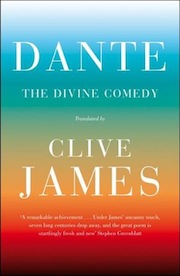
The Divine Comedy, translated by Clive James. Liveright/ W.W. Norton. 526 pgs.
No one wants to sit by a hospital bed for two weeks with the grief of the inevitable, but that is when I read Clive James’ newly translated version of Dante’s The Divine Comedy. I thought three things as I read: 1) Dante and James did not really know Hell as I do; 2) One shouldn’t think ‘now there are only 300 pages left;’ 3) ‘Who needs another translation of Dante?’ Then I realized, ‘I do.’
Clive James is the most estimable of writers and, in this book more than ever, we know why. The clear lush lyricism is hypnotic reading. The book is blurbed as ’whole, unified and dramatic.’ This is one time the PR doesn’t come close to praising the actual product. I was surprised by how much action/adventure there was in translation and how much in Dante I had not appreciated before.
The Divine Comedy was written by Dante Alighieri between 1308 and his death in 1321; it’s an allegory of the afterlife in three parts: Inferno, Purgatorio, Paradiso. “The Soul’s journey toward God.” From Canto 3 “Forget your hopes. They are what brought you here.” I can only suggest that there’s nothing wrong with finding Dante pleasurable reading rather than scholarly (this is not laden with footnotes,) and this rendition manages to capture motion more than I had seen before. The lyrics move fast to make it good for us to read. The compact precision—written in quatrains which are not discernible—make words of perfect timing and so it becomes song. I always read the introduction last in every book to see how I managed without it, and I was moved by the association of the writer to the inspiration of his wife. There was for me a personal symmetry, unity and beauty in my reading at this time. In Canto 20 we are in Hell and here is a sample of the textual magic of Clive James.
Dante
(From Book 1 – Hell)
It’s Book One, Canto Twenty. I must make
New matter and new verses from the pain
Of those in these depths, where the floor’s a lake
Of anguished tears I stare at tight with strain,
Seeing them come along the valley’s curve,
These silent people weeping, at the pace
Of worldly litanies. I needed nerve
Even to notice, there below each face,
The twist between the upper chest and chin.
The head faced the behind, and thus they came
Reversed, so as to see in front. If in
Some case of palsy it has been the same,
A man turned right around, I have not seen
Such things, nor do I think they can by true.
So God grant, reader, you yourself should glean
Fruit from your reading, and think how I knew
To keep dry cheeks when I saw from close by
The human form so twisted that its eyes
Could bathe with tears its rearward cleft. And I,
I wept indeed, held up in my surprise
By one rock of a ridge. My escort said:
“You’re witless as the rest? Here pity dwells,
But only when it’s absolutely dead.
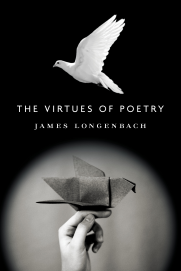
The Virtues of Poetry, by James Longenbach. Graywolf Press. 158 pgs.
My present, pleasant regime at this time in my life is to read one book of poetry a day. (Anthologies not included.) But when it comes to prose, I need to expand time. Luckily a recent contract came with a car and driver to another city which gave me what I needed to read The Virtues of Poetry. Longenbach is a critic and poet so his approach is analysis, with an intimate knowledge of process. He states the purpose of the book is to see clearly ‘… the thrill of disorder is produced in art by exquisitely crafted means.’ His job is to show us how it’s done. And it’s no detriment to the art to hear Longenbach on Dickinson, Whitman, Donne, Pound, Eliot, Ashbery, and much more. What I like is how he explicates the logic of poetry, distinguishing each poet’s particular use of timing, dead spots, and acrobatics—more commonly known as “craft.” Goodbye to mindless possibilities; we learn that these are doors through which the accomplished poet arranges the consequences of thought and form. Make no mistake—Logenbach believes in poetry of the soul but is mostly interested in how that becomes physical matter, i.e. diction, tone, syntax, meter, etc. I, for one, can use all the help I can get in this department because it’s too easy for me to dream into a poem than realize how messy T.S. Eliot was with some of his fragments. This book is behind the scene, behind the lives writing. Criticism at its best—easy translations of hard writings.
The awareness of poetry writing is not always evident, but readers seek sense in writing! And they wish to understand what is being said, no matter what the style. Logenbach’s special skill is allowing his line of vision to take us into the poet’s plot, plan and execution of the poem.

Writing Poetry to Save Your Life: How To Find The Courage To Tell Your Stories, by Maria Mazziotti Gillan. Miroland Press. 196 pgs.
Maria Gillan is the most no nonsense poet and teacher writing today. She starts her book by saying, ‘Poems hide in a place deep inside of you thatI call a cave. The cave is guarded by a crow that whispers in your ear in the voice of every authority figure that you’ve ever encountered. The crow tells you all the reasons why you can’t write, shouldn’t write. He tells you everything that’s wrong with you…’ This is the heart and soul of ensuing chapters, a veritable toolbox for creativity, and the mantra is courage, strength, truth. Gillan has practiced her trade with these merits; and she’s taught 1000’s of students the difference between artifice and experience. The book is as much about self-creation as it is liberating the word and her crisp direct advice— along with the full import of her sample poems—is a verbal triumph.
I know Gillan’s poetry well; and the rereading of her poems is a perfect mesh of her philosophy and wisdom. She proves that poets do not change to suit the time or fashion. They are not decorators and adorners. The truth of the poem is its interiority— the heart—wordplay will follow. The book provides pages and pages of prompts that work for every age group, up and through the professional. In essence, the book is a cautionary tale to all truthseekers: Be Careful of What You Do Not Write.
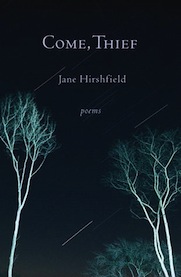
Come Thief, by Jane Hirshfield. Alfred A. Knopf. 87 pgs.
Any day there is a new book by Jane Hirshfield all the lights in the world go on. It’s not about the subjects of the poems, it’s how they become protean. She may write about an egg, sheep, leaves, Alzheimer’s, a pear— the word that comes to mind about her writing is incorruptible. There is a pure tone from word choice that makes up diction of peacefulness, acceptance of the world, and a heart that’s trusted to do the right thing with this art. I like, especially, the poem Fifteen Pebbles where tiny poems respond to the titles which are signposts and magnets for the following thoughts. Ex: Pebbles # 14
The Same Words
Come from each mouth
Differently
There is sometimes a Zen or Eastern thought, as in the poem One Loss Folds Inside Another: One loss/ folds itself inside another./It is like origami/ held inside a plain sheet of paper./ Not creased yet./ Not yet more heavy./ The hand stays steady.
There are characters in the poems too, because Hirshfield knows that’s what the world’s about. In Critique Of Pure Reason—a woman in her nineties finds the opened drawers of her late husband’s dresser and soon the poet crosses us back and forth across time, like novelists do: “…the Yiddish jokes of Auschwitz… a dog watching a tennis ball lobbed into darkness…” These are heart stopping images that move to “…the goat stands patient …watching without judgment from his strange eyes…”
Perhaps this is what I mean. There’s no judgment in Hirshfield’s poetry. She declares and describes sometimes from a knowing place but there is no obsession/attachment about what she sees. For, like all great poets, the art stands still and let’s all else move past it. So the poem is a kind of statue of all that is in motion, and; is the love of things seen in passing.
Both a narrative and lyric poet, Hirshfield holds her place at the top of the canon of writers today.
SHEEP
It
is the work of feeling
to
undo expectation
A
black-faced sheep
looks
back at you as you pass
and
your heart is startled
as
if by the shadow
of
someone once loved.
Neither
comforted by this
nor
made lonely.
Only
remembering
that
a self in exile is still a self,
as
a bell unstruck for years
is still a bell
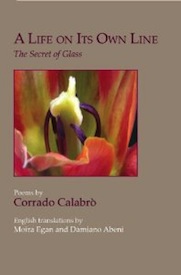
A Life on Its Own Line, by Corrado Calabrὁ. Translated by Moira Egan and Damiano Abeni. Entasis Press. 151 pgs.
2013 is Anno Della Cultura Italiana, Year of Italian Culture, the Italian arts celebrated throughout the USA. One such event featured a visit from Rome, by poet Corrado Calabro. His new bilingual book of poems has a Washington DC publisher, and translators who are poets. Italian contemporary poetry (with a few exceptions) holds the tradition of neoclassicism no matter the topic, and this speaks of a care in making the poem to embody form. The topic can be startling, even revolutionary, but Italian poets are formalists disguised as narrators or lyricists. The theme here is l’amore—whether with nature or relationships. The book’s subtitle is “The Secret of Glass;” and that’s suitable, for the poems read smooth and clear, moving from mystery to clarity. Poetry depends on opposites and these poems present small conflicts and personal hindrances to finding fulfillment. Some are theater pieces with characters in motion; others, tableaus—a moment in time. The poet confronts himself with illusions and realities of love and the poem often veers toward the unexpected. If ever a poet is the beholder of his/her interior life, it is true here. Each poem acknowledges an emotional event, its effect upon the ‘speaker’ in the poem, and a conclusive thought. American contemporary poetry doesn’t seem to pursue the romantic notion as commerce for poetry. It seems American poetry is more cynical in comparison, more disruptive. Since the cultural revolution in the 1960’s & 70’s U.S.A., poetry tackles change and thus sometimes turns on ideals as myths made to deconstruct. But Calabro lives in the luminosity of the possible, his search is for ultimate satisfaction, poetry of longing. Remember, the Greek/Roman ideals of beauty and love are gold standards in art, and thankfully philosopher/poet Calabro remains strong, internationally, in this literary tradition.
Tram Number Two
What a thump in my chest when tram number 2 appears!
Supple,
it turns the bend
it
runs with narrow flanks down the strait,
suddenly
it appears under my window
and
it looks as if it’s going to miss its stop,
but
then it does halt, just a bit down the road.
Two
people get off, no – only one.
She
shakes her hair, crosses the street,
lifting
her umbrella: it’s a girl,
a
woman around thirty,
it’s not you
and also this from Corrado Calabro:
Intervals
there are no notes
without silences
no trains without stations
no flights without landings
no dreams without awakenings
no inspirations without expirations
no words of love
without white spaces.

CHAPBOOKS. This form of publication is a time-honored American offering. All our greats did it. All our Laureates and Pulitzers at one time or another do it. At some time or another there’s reason for a poet to want to put out a work of 30 pages, more or less, that doesn’t quite come up to the need for our standard 42 page book of poems—only regulated I believe by the fact that it takes that many pages to make a spine. So chapbooks are typically stitched or stapled and should not, because of this, be thought of as 2nd class citizens.
Book of Hooks, Vol. 1 &2 by Cornelius Eady. Kattywompus Press. 31&29 pgs.
Cornelius Eady is a seasoned poet, and co-founder of Cave Canem. We read his poems in the New Yorker and our best places. Now he has turned to music with two chapbooks Vol. 1 and Vol. 2 containing song lyrics and the songs themselves in CD form. I’ve been playing them quite a lot and following the page and I find that poets who are songwriters have more lyrical antics than songwriters who are not poets. This makes it more interesting for me because the language is not subordinated as entry point for music but is the action itself; and, with music showing what language is capable of. These chapbooks plus music show what discipline it takes to manage instrumentation, a constellation of feelings, and ideas worth hearing. Also some social judgment is here and that’s what makes Cornelius Eady such a valuable member of this world.
Words: Cornelius Eady
Music: Bernie Heveron & Cornelius Eady
Fish
Ummm
Ummm
Ummm
Ummm
I
don’t know where I’ve been
Don’t
care where I’m bound
Might
be a wingless angel
Might
be a fish that drowned
I
don’t know who I was
Can’t
tell what I’ll be
Might
be a busted flush
Might
be the lottery
Gotta
shirt on my back
Got
some miles on my shoes
When
you got empty pockets
No
one can pick your blues.
Beautiful
women
Sure
ain’t for me
Soft
feather bed’s
A
hobo’s fantasy
A
lucky break
Sure
ain’t my stile
It’s
hard knock and dirty sock
Mile
after mile
I
don’t know where I’ve been
Don’t
care where I’m bound
Might
be a wingless angel
Might
be a fish that drowned

The Living Clock, by W.M. Rivera. Finishing Line Press. 28 pgs.
W.M. Rivera is an economist, agronomist, and educator by trade but he retired the letter of life’s law for the spirit of the law, and his life is now one of poetry. Rivera is smart and accomplished — two good qualities to create his poetic designs. He can observe the natural beauty of the day with a full understanding of its camouflage – and he uncovers complexities with an exploration of ideas and a magnification of sight. The power of the image is his strong point; and, his is language that doesn’t let us down.
Song
bubbles in the universe
“You
said: ‘I’ll go to some other place, some other sea’”
C.P.
Caváfy
Yes,
Caváfy, I’m indebted to you;
you
say the ruined life in one place stays
ruined
elsewhere. It’s true. I’ve gone
other
places and this morning’s silence
gnaws
no different… other seas, other
indefinites,
lemniscate wanderings;
in
the scratch of blackboard sentences
much
is erased, forgotten, ruined.
But
the dictum’s limited. Life’s beyond
I
or me or any other wastrel. Life wastes life…
place
after place, greed, hate. Meanwhile Sun sings;
song
bubbles in the universe; slow sounds
explode.
Space filters down; even now dust
settles
pound by soft accumulating pound.

Calling Old Ghosts to Supper by Sonja James. Finishing Line Press. 27pgs.
Sonja James is one of my favorite women poets in all of America and I have watched her seismic talent grow with her confidence of life. She uses a time of mental action to preempt logic, and create magic thought. No one can put together the disparate images like James can, to create such a secret garden with mysterious flora and fauna made up of just the regular old language all of us know. Her playfulness and puzzling ability to soar above the mundane is poetry that allows a moment of happiness. In reading her I’m always saying, She’s the first person to say it this way, and better still, no one else would dare. Her work floats with a contour of subtleties which I love because I trust her to say the right thing and land on her feet while skipping joyfully from one line to the other.
Hello
Midnight
It
does not matter that the oranges
sing
in their bowl
or
that our eyes turn in their sockets
to
conspire with the shade of the trett.
The
future daunts like an unknown language
whispers
at dawn.
When
we journey to the temple
carrying
the liver of an ox,
we
know that no god will taste of it
and
that someday we’ll die
leaving
a trail of spent moments
as
ephemeral as the tears of a frog.
Even
so,
we
arrange our hands just so,
unleash
the wolf of regret,
summon
our disappointments,
and
record all dreams in a book.
Then
we hide our bones in the clouds
and
bandage our feet with silk
before
covering our arms with light.
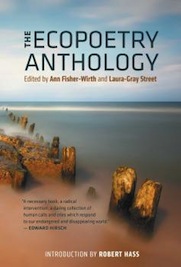
Best Anthology. POETRY MONTH’S EXEMPLAR
The Ecopoetry Anthology, edited by Ann Fisher- Wirth and Laura-Gray Street. Introduction by Robert Hass. Trinity Univ. Press. 576 pgs.
Poetry and nature share the commitment to something bigger than “the self.” Editor Ann Fisher-Wirth talks about breaking ‘through our dulled disregard, our carelessness, our despair, reawakening our sense of vitality and beauty of nature.’ Editor Laura Gray-Street looks at ecopoetry as ‘a way of thinking.’ Robert Hass has a 25 page introduction contextualizing this movement from John Donne to Gary Snyder, including the emergence of geology as a science— to Charles Darwin—moving through humanistic history—enfolding American nature poetry as part of the development of ecopolitics, ‘toward the necessity of imagining a livable earth.’
The book is divided into two parts: “Historical” and “Contemporary.” Part 1 features 30 poets and if you’ve ever taught or studied poetry, the poet you learned is here. Same with Part 2…maybe 150 contemporaries, each with name recognition. Everyone you love. A way to begin with a book for lifetime reading is to open it at random and see what falls out— poem after poem literalize a contest of force. There is so much power in this book—poems not written for “a task,” rather, these are poems revealing depths of feeling with variations of style, textures, and thought. What impresses me about anthologies—that if poets had been commissioned for the topic, we would have a different molecular structure. These poems are collected from writers because of their love of things seen and understood about nature. They are not of their own dreams and ambitions, but reverence for something better. In each, mysteries of nature are uncovered, examined. I’ve always thought poetry could change the world, and with the best energies of Robert Hass, Ann Fisher-Wirth and Laura-Gray Street, and these assembled poets, I believe we have a chance—someone coined a phrase which I will use: “The loving enemies of indifference.”
Lucille Clifton, with a poem here:
The earth is a living thing
is a black shambling bear
ruffling its wild back and tossing
mountains into the sea
is a black hawk circling
the burying ground circling the bones
picked clean and discarded
is a fish black blind in the belly of the water
is a diamond blind in the black belly of coal
is a black and living thing
is a favorite child
of the universe
feel her rolling her hand
in its kinky hair
feel her brushing it clean
and this by Kevin Simmonds (Ecopoetry Anthology)
Sighted
Nature
poet handling his plume
Urban
poet his switchblade
Each with wings unfolding in their hands
One
travels the boned corset of cactus
Sky
lifting its hoop skirt to a meringue of stars
The
other eulogizes children fallen from loveliness filed
into
caskets.
Both
behold faces turning to see
and
be seen
They scatter the broken mirror everywhere
Very Honorably Mentioned: Two Periodicals cited for National Poetry Month: Poems, Prose, Interviews, Art:
Little Patuxent Review, edited by Laura Shovan. LPR Inc. publishers, 93 pgs.
Yomino-16 (Japan,) edited and published by Suzanne Kamata. 84 pgs.
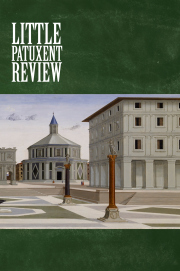
Grace Cavalieri is a poet and playwright. She produces “The Poet and the Poem from the Library of Congress” for public radio.
